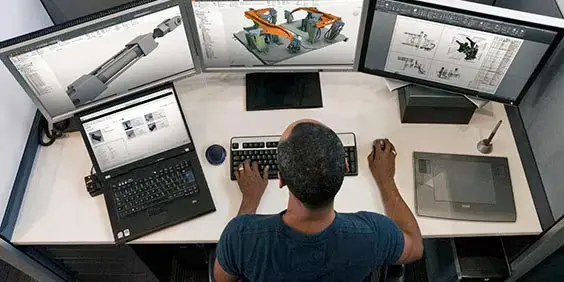Cost Comparison Of Mechanical Engineering Contractor Vs Full-Time Employee (Real Pay Data)
While it may not seem like a big deal but in reality, choosing a contractor or full-time employee can impact your construction projects greatly. The New York Times quoted that OnContracting estimates suggest a technology company can save up $100,000 by hiring a contractor. But that doesn’t mean contractors are always a better choice for construction projects.
There are several circumstances where full-timers turn out to be profitable and efficient in terms of task execution. This blog will compare both of the choices and help you assess which one is ideal for your next big construction gig. Before we jump into the comparison, let’s briefly analyze both options.
Brief Overview Of A Freelance Mechanical Engineer
36% of the global workforce is transitioning towards freelance careers, and there’s a reason behind it. As the name suggests, a freelance mechanical engineer may work on a fixed-term or renewable contract. That means a contractor has no direct contact with the company’s day-to-day tasks.
The perks are not only for contractors but for the client as well. While the hourly rate of hiring mechanical engineering contractors is higher, they turn out to be a cost-effective option in the long run. There would be no hiring or recruitment costs. Also, the work can start immediately, unlike full-timers, who need to be trained first.
Pros Of Hiring A Contractor
- No Annual Bonus
- No Tax Hassle
- Fewer Employer Rights
- Cost-effective For Certain Projects
- Doesn’t Need National Insurance Contributions
- No Fuss Of Management Or Monitoring
Cons Of Hiring A Contractor
- Higher Hourly Rate
- Lacks Real-time Monitoring and Interaction
- No Control Over The Contractor’s Schedule
Brief Overview Of A Full-Time Employee
According to the Internal Revenue Service, a full-time employee is dictated by the employer about how, when, and where to work. Simply put, being an employer, you can supervise, influence, and oversee how the work is done. In most states, the hourly rate of hiring a full-time contractor is less than freelance contractors. However, tons of different hidden expenses that increase the total cost.
An employer can’t just give base salary to full-time mechanical engineers and expect everything to be accounted for. There are G&As, overheads, insurance, and fringe benefits, which add a hefty sum to the total cost of hiring. Here are some pros and cons of choosing full-time salaried individuals.
Pros Of Hiring A Full-Time Employee
- Collaborate Across Departments
- Reliable And Consistent Services
- Allows Real-Time Supervision
Cons Of Hiring A Full-Time Employee
- Costly Compared To Contractors
- Extra Effort Is Needed To Monitor And Manage Their Tasks
- Need Tools, Training, Insurance, And Retirement Plans
Here’s a real-world comparison table based on signifying factors. This will help you make an informed decision.
| Factors | Mechanical Engineering Contractor | Full-Time Employee |
| Insurance | Covered By Contractors | Mandatory |
| Provident Fund | Not Applicable | Contributed by Both (Employer and Employee) |
| Payroll Taxes | Not Applicable | Responsibility Of the Employer |
| Professional Tax | Not Applicable | Applicable To Employee |
| Control And Independence | No Control of Work Schedule for Employer | Organizational Supervision Perks For Employer |
| Fringe Benefits | Not Applicable | Employer’s Responsibility |
| Recruiting Fees | Not Applicable | Added During Hiring Process |
| Annual Bonus | Not Applicable | Included in Most Cases |
| Social Security Contributions | Not Applicable | Contributed by Both (Employer and Employee) |
Complete Cost Breakdown Of Hiring A Contractor
Hiring a contractor may seem like a straightforward task, but there are several things to keep in mind to get the ideal candidates. Firstly, ensure you find the contractors who know the tactics to supply exceptional results without any delays. Only experienced mechanical engineering contractors can do so.
|
Important Note! |
|
Contractors do not have special taxation requirements. However, the employer must supply a 1099 Form through IRIS (Information Return Intake System). |
Remember that the hourly rates of contractors keep varying across the states in the US. So, you need to calculate the total project expense as per the state of your construction site.
Apart from hourly rates, you can also consult and decide a full-task price for the whole mechanical engineering service. These prices are based on the amount of resources and efforts used by the contractor. However, per hour is a better choice to test things out. Here’s a list of average per-hour and per-annum rates of freelance mechanical engineering contractors across major states in 2025:
| US States and Cities | Average Per Hour Rate | Average Annual Rate |
| Washington | $53.83/hour | $111,900+ |
| Alaska | $52/hour | $108,100+ |
| New York | $52/hour | $108,100+ |
| Massachusetts | $52/hour | $108,100+ |
| Sita, AK | $53/hour | $110,300+ |
| Atherton, CA | $53.36/hour | $110,900+ |
| Berkeley, CA | $54/hour | $112,100+ |
| California | $54.50/hour | $113,000+ |
Hidden Costs Associated With Freelance Contractors
You may think the total cost of hiring a freelance contractor is assessed by multiplying the per-hour rate by the number of working hours. However, it is not that easy! Several hidden costs add a great deal to the total hiring expense. Here’s a quick rundown of the most common ones:
●Turnover delays
You cannot manage or oversee the work being done by the contractor in real-time. So, there are chances the services get delayed for some reason. For instance, if you are using mechanical engineering design services, it is vital to get blueprints in time. Any delay can cause permit-related issues and even lead to cost overruns.
●Potential retraining
Contractors do not need training for the task. These are not interns but experienced professionals who’ve been in the market for years. However, they will need retraining exercises or guidelines to adjust according to your company’s SOP. That can take time, and failure to comprehend the rules can lead to revisions and extra expenses.
●Less niche-specific knowledge
If you try to cut costs and find a contractor with a low hourly rate, you’d probably have to compromise on quality. Moreover, a contractor with less experience in your specific niche will demand lower rates. However, there’s a slight chance of errors and clashes in the results. So, make your decision wisely.
Analysis Of A Full-Time Employee’s Salary
Unlike a contractor’s cost breakdown, a full-timer’s salary calculation is much more complex and diverse. Every state has varying base salaries of full-time mechanical engineers similar to contractors’ hourly rates. These are comparatively lower than the hourly rates. However, things change when we add taxes, equipment cost, training, and other hidden fees.
The individual hidden charges will be streamlined later on in the blog. However, to account for all the additional costs, we can use a cost multiplier for now. The related surveys and data gathered in 2005 suggest that a multiplier of 1.35-1.75 can be used to calculate the actual total cost of hiring and managing a full-time mechanical engineer.
A recent report by Grant Thornton states that the latest estimated cost multiplier should be 1.99. That means each permanent employee will cost a company twice their base salary. Here’s a table listing base salaries of different states and the actual hiring expense according to the latest cost multiplier:
| US States and Cities | Average Base Salary (Annual) | Total Estimated Cost |
| Washington | $116,500 | $231,835 |
| Alaska | $106,800 | $212,532 |
| New York | $112,500 | $223,857 |
| Massachusetts | $112,300 | $223,477 |
Hidden Costs Associated With Full-Timers
Unlike contractors, a full-time mechanical engineer is associated with tons of different hidden costs. These can be added separately in conclusion or calculated through the cost multiplier. Here is the individual assessment of primary hidden costs for hiring full-time mechanical engineers:
●Kiwisaver Costs
This cost is solely related to the employer. As per law, an employer is required to add at least 3% of the total salary of an employee to their KiwiSaver account.
● ACC
Accident compensation corporation is one of the primary hidden costs that add a hefty sum to the total cost. The ACC levies range from $0.30 to $2.00 for every $100 of an employee’s salary.
● Insurance
Employers are required to include medical, dental, and vision insurance for workers. 2023 data suggests that the average employer-sponsored insurance was $23,938.
● Taxes
One of the biggest hidden costs involved in full-time employee hiring is tax management. The US government imposed several taxes on employers to ensure workers’ safety and working rights. Here are some of the common ones:
| Tax | Detail |
| FICA Taxes | These include two separate sectors of taxes. 6.2% of employees’ contribution goes to the Social Security Department of the US. 1.45% of the total contribution goes to Medicare. |
| FUTA and SUTA (Unemployment Taxes) | These vary within states. For instance, the SUTA tax in Oregon was 2.4% in 2024, and the FUTA tax rate was 6%. Both of these were paid from only the first $7000 earned by the employee in wages. |
| State-Specific Taxes | There are some extra payroll taxes in different states. Oregon has a state income tax that is of a progressive nature. It ranges from 4.75% to 9.9%. Moreover, there’s a statewide transit tax for employee wages (0.001%). |
● Training
Training costs vary in different industries. Moreover, the type of task also changes the total training expense. According to recent surveys, training expenses are within 1% to 5% of an employee’s actual salary.
● Equipment Expense
The cost of equipment can change according to the tasks of the employee. Some equipment is more expensive compared to others. That’s why it is necessary to assess and add related equipment costs according to the desired mechanical engineering equipment.
Choose Smarter, Hire Right
A Real-World Comparison Table
Hiring is about understanding the actual cost each option brings to your business. Full-time engineers come with benefits, compliance overhead, and training expenses. On the contrary, contractors may command a higher hourly rate but avoid the long-term extras. The table below shows how those costs stack up in practical terms.
| Category | Full-Time Mechanical Engineer (US Example) | Contract Mechanical Engineer |
| Base Pay / Hourly Rate | Approx. $45–50/hr ($95- $120,000/year salary) | Typically $50–80/hr for mid-level; $100–200/hr for senior-level experts |
| Benefits & Employer Taxes | Adds 30–35% of salary for health insurance, retirement, and payroll taxes | Contractor handles their own taxes and insurance |
| Administrative & Overhead Costs | Office space, HR, payroll, legal, and admin overhead can double the base cost | Minimal overhead beyond payment processing |
| Training & Equipment | The company covers onboarding, software, tools, and mentoring. It can exceed $25K | Contractors typically use their tools and arrive project-ready |
| Turnover & Ramp-Up Risk | Lower turnover, but longer onboarding time | Faster to hire, but may require retraining if turnover is high |
| Flexibility & Scaling | Less flexible, fixed payroll and headcount constraints | Scale up or down per project without long-term commitment |
| Typical Break-Even Duration | N/A | Contractors are often more cost-effective for projects under 6–8 months |
Contractor Vs Full-Time Mechanical Engineer | What Works Best and When
Sometimes, deciding who to hire isn’t about cost but about the fit. Some jobs need someone fast and laser-focused. Others need a long-term team player who lives and breathes your product. We will give you some suggestions according to the type of projects for a better assessment.
Projects Where Contractors Shine Bright
Here are the types of projects where contractors crush it:
Rapid Prototyping and One-Off Builds
Need a concept turned into a working model instantly? Contractors are perfect here. They’re used to diving in, figuring things out fast, and getting results without endless meetings.
You don’t have time to train someone or explain your entire company history. You need someone who knows CAD, simulation tools, and how to bring rough ideas to life quickly. Contractors do this kind of work every day.. The best part is they’re used to tight deadlines and weird requests.
Simulation and Analysis Work
For tasks like finite element analysis, computational fluid dynamics, or vibration analysis, you want a specialist. This stuff is niche. It requires specific software and experience. Full-timers might not touch these tools regularly, but contractors who live and breathe this type of work can come in, run the numbers, and deliver polished results.
Short-Term Product Redesign or Troubleshooting
Contractors are good at reverse engineering, redesigning enclosures, tweaking tolerances, or improving performance. This is another area where bringing in a fresh set of eyes on a contract makes more sense than overloading your full-time team.
Project Overflow or Temporary Team Boost
Sometimes your in-house engineers are slammed. You’ve got deadlines piling up. So, instead of stretching your team too thin or saying no to new work, you bring in a contractor to help carry the load.
Projects Where Full-Timers Are A Better Choice
If you have any of these projects at hand, full-timers are your best bet:
Long-Term Product Development
If you’re building a complex product that’s going to evolve over the years, a full-time mechanical engineer makes sense. They’ll stay in sync with the rest of your team, track changes, and carry design knowledge from version 1 through version 12. Contractors can lose context after the first round, but full-timers live in the details.
Manufacturing Support and Process Improvement
Manufacturing lines need constant attention. Things break, parts go out of spec, and tolerances drift. Full-time engineers can spot long-term issues, develop fixes, and improve efficiency over time. They work closely with production staff and become a critical part of keeping things running.
R&D and IP-Heavy Work
If you’re inventing something new or creating proprietary tech, keep it in-house and hire full-timers. They help file patents, experiment with wild ideas, and iterate until something works. Plus, keeping IP close to your chest is just smart business because contractors might not stick around or fully understand the big picture.
Common Hiring Mistakes To Avoid While Hiring
Even smart teams mess this up. You think you’re saving money, but end up spending more. Or you hire too fast and get stuck fixing someone else’s mess. Here are some of the most common slip-ups when hiring mechanical engineers:
- Don’t hire a full-time employee for a short-term project. It can lead to unnecessary long-term costs.
- Try to be certain of all the hourly costs and do not assume them. It will save your total estimate from being misleading and financially risky.
- Don’t forget to factor in the cost of tools, licenses, and software for full-time staff. It can add unexpected expenses.
- Delaying the hiring process results in lost productivity and team burnout. So, it is better to refrain from it.
- Don’t skip a test project or trial task. It can increase the risk of hiring someone who’s not the right fit.
- Never underestimate the time it takes for a new hire to get familiar with your systems. This will help you eliminate all the frustrating slowdowns.
- Focus on key details in a contractor’s agreement, like intellectual property terms or exit clauses, to save yourself from legal troubles.
- Do not completely rely on a full-time hire to figure out specialized tasks without proper expertise.
- Get a team and make hiring decisions based on their suggestions. Doing it without input from your team can lead to poor choices and missed red flags.
Conclusion
There’s no one-size-fits-all when it comes to hiring mechanical engineers. Sometimes you need a brain on demand that can solve a weird problem fast. Other times, you need someone who’s going to be around for the long haul, knows your product inside and out, and can handle the grind. If your project is short, specialized, or high-speed, a contractor is usually the better bet.
You’ll pay more per hour but dodge a mountain of extras. If the work is ongoing, high-impact, and tied to your core business, a full-time engineer is worth every dollar. The key is knowing what the job actually needs, not just today, but three months from now. And if you’re still unsure, start small and hire for the short term. That way, you don’t just fill a seat but build a perfect team.






